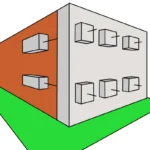What is white work?
White work refers to the construction phase where all the necessary tasks are carried out to make a dwelling ready for habitation. In other words, it encompasses everything non-structural but related to finishes (although some separate the finishing stage into another phase called “fine work,” it is generally included in this one). This stage follows the shel construction and the gray work. White work includes all essential systems and components that make a home functional, comfortable, and safe. In this article, we will delve into all the necessary aspects to understand it:
Differences between shell construction, gray work, and white work:
Shell Construction: It is the initial stage of construction focusing on the structure and support elements of the building. It includes foundations, columns, beams, load-bearing walls, roofs, and drainage systems. shell construction establishes the foundation for the subsequent stages.
Gray Work: Gray work refers to the installation of basic systems and services in the dwelling, such as electricity, plumbing, and the heating or air conditioning system. It also includes elements like interior partition walls and stairs. Gray work is the preparation for white work, providing the necessary infrastructure.
White Work: As mentioned earlier, white work is the phase where the installation of elements that makes the dwelling habitable takes place. This includes:
– Electrical installation: Wiring and points of light, plugs, and power outlets are placed.
– Plumbing: Pipes and fixtures for potable water and drainage are installed.
– Heating and cooling systems: Radiators, boilers, air conditioning, etc., are mounted.
– Thermal and acoustic insulation: Materials are added to improve energy efficiency and reduce noise.
– Interior carpentry: This includes doors, windows, frames, and other necessary carpentry elements inside the dwelling.
– Wall and ceiling coverings: Materials like plaster, drywall, or other coverings are applied according to the design.
– Floors: Flooring such as tiles, parquet, or laminates are installed.
– Interior painting: The interior of the dwelling is painted in selected colors and finishes.

Importance of white work:
Although traditionally associated with the essential and functional aspects of a dwelling, white work plays a fundamental role in building a home that goes beyond mere practicality. It carries an implicit significance that is crucial for every individual, encompassing multiple dimensions:
Firstly, the quality of white work is a critical factor for the well-being and comfort of residents. High-quality thermal and acoustic insulation, for example, creates a more comfortable and relaxing indoor environment. Temperature remains constant, cold drafts are reduced, and annoying external noises are minimized. Additionally, the functionality of electrical and plumbing systems has a direct impact on daily comfort. The ease of turning on lights, using appliances, and enjoying a constant and reliable water supply influences the overall perception of comfort at home.
Another fundamental aspect is the ability of white work to serve as a blank canvas where occupants can imprint their identity and personal style in the dwelling. From choosing wall colors to arranging furniture and lighting, every detail can completely transform the atmosphere, making the home unique and welcoming. This customization is essential to turn a house into a home that reflects the personality and tastes of its inhabitants.

In addition to improving the present, high-quality white work can have a long-term impact on the quality of life in the dwelling. Premium materials and systems not only offer greater comfort but can also translate into benefits such as energy efficiency, durability, and cost reduction over time. This investment in quality translates into higher property value and a more rewarding living experience.
Finally, white work provides a crucial sense of security for residents. Proper installation of electrical and plumbing systems, along with compliance with building standards, provides the peace of mind that technical aspects of the dwelling are well-resolved. This home security is an essential component of quality of life and contributes to an environment where residents can feel protected and comfortable.
Where does white work end?
White work usually concludes when all the aforementioned systems and components are installed and functioning properly. The dwelling is ready to be inhabited, but fine finishes are still pending, such as the selection of wall colors, textures, floors, and other decorative details. White work precedes fine work, which includes the application of decorative finishes and the installation of elements like lighting fixtures and furniture.
White work in a housing project is an essential phase situated between shell construction and fine work. It includes the installation of all necessary systems and components to make the dwelling functional and habitable. Its quality and efficiency are crucial for the success of the construction project and the well-being of its future residents.
Quality and safety in white work:
The quality of white work is essential to ensure the safety and durability of the dwelling. Errors at this stage can lead to serious problems in the future. It is important that all work is carried out in accordance with local regulations and construction standards.
Moreover, safety is a significant concern in white work, especially regarding electrical installation and plumbing. Poor work in these systems can pose a risk of fire or water leaks, potentially damaging the structure and finishes of the dwelling.

Costs of white work:
White work usually represents a significant part of the total construction budget. Costs can vary depending on the geographical location, size of the dwelling, materials used, and the complexity of the installed systems. Proper planning and a realistic budget for this construction phase are important. White work typically accounts for approximately 30% to 40% of the total construction budget in a housing project.
Aesthetic aspects of white work:
White work, often considered the fundamental stage in the construction of a dwelling, goes beyond the purely practical and plays a crucial role in creating truly impressive aesthetics. Since, at the end of this stage, the dwelling must be in optimal functional and aesthetic conditions to provide proper quality of life to its inhabitants, it should be approached with great care.
White work lays the groundwork for the subsequent application of fine finishes, providing a carefully prepared and leveled surface that will serve as a blank canvas for expressing creativity in decoration and interior design. It is the starting point where architecture and aesthetic vision merge, allowing designers and homeowners to unleash their imagination. The choice of colors, textures, and decorative elements becomes an artistic act that breathes life and personality into every corner of the home.
Although theoretically, this stage is not considered for the application of fine finishes, in most housing projects, it is fully completed, meaning fine finishes, painting, and lighting. As we have delved into earlier, aesthetics is one of the most challenging aspects, not due to the labor it might entail but rather due to the individuality of each client or future inhabitant of the property, as beauty itself and the sense of comfort become ambiguous and subjective aspects. This relativity of thought can be a real headache for many architects and engineers because it must always be considered that beauty and aesthetics in a structure or any work can affect aspects we may not even imagine.
For further insights on aesthetic topics, you can refer to Aesthetics in Engineering and Architecture.
About The Author
Samuel Parariá
Estudio: University of Francisco de Paula Santander.
Major: Civil Engineering.
Favorite Areas: Structures, Traffic Engineering, and Road Design.
Location: Cúcuta, Norte de Santander, Colombia.







Related
Gravity Retaining Walls
What are Anchored Retaining Walls?
Methods for Paver Calculation – Civil Engineering